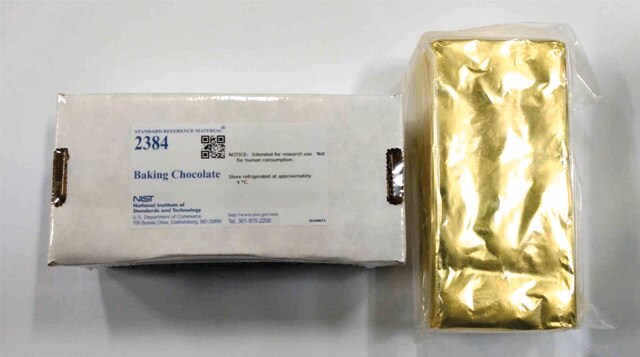NIST1573A
Tomatenblätter
NIST® SRM® 1573a
Anmeldenzur Ansicht organisationsspezifischer und vertraglich vereinbarter Preise
Alle Fotos(1)
About This Item
UNSPSC-Code:
41116107
NACRES:
NA.24
Empfohlene Produkte
Qualität
certified reference material
Qualitätsniveau
Verpackung
pkg of 50 g
Hersteller/Markenname
NIST®
Format
matrix material
Allgemeine Beschreibung
Anwendung
Tomato leaves has been used as a standard reference material
- in evaluating the cloud-point extraction methodology for copper and nickel determination in food samples
- for determining the precision of energy dispersive X-ray fluorescence spectrometry (EDXRF) method for nutrient analysis
- in evaluating the accuracy of high resolution continuum source flame molecular absorption spectrometry (HR-CS-FMAS) for determination of sulfur in food
- for evaluating the accuracy of thermospray flame furnace atomic absorption spectrometer (TS-FF-AAS) in cobalt determination in biological materials
Biochem./physiol. Wirkung
Tomato leaves is rich in calcium, magnesium, potassium and phosphorus. Other minor nutrients present in leaves includes sulfur, boron, manganese, iron, copper, zinc and molybdenum. All these nutrients constitute for the macromolecules like protein and nucleic acid. Also, helps in regulating the enzymatic activity of the plant, and for normal growth and reproduction.
Sonstige Hinweise
Certified for the analytes listed below. See certificate for values and more details
Kjeldahl Nitrogen, Nitrogen (Total), Phosphorus
Trace Elements: Aluminum (Al), Antimony (SB), Arsenic (As), Barium (Ba), Boron (B), Bromine (Br), Cadmium (Cd), Calcium (Ca), Cesium (Cs), Chlorine (Cl2), Chromium (Cr), Cobalt (Co), Copper (Cu), Gadolinium (Gd), Hafnium (Hf), Hydrogen (H), Iodine (I), Iron (Fe), Lanthanum (La), Magnesium (Mg), Manganese (Mn), Mercury (Hg), Molybdenum (Mo), Nickel (Ni), Potassium (K), Rubidium (Rb), Samarium (Sm), Scandium (Sc), Selenium (Se), Silver (Ag), Sodium (Na), Strontium (Sr), Sulfur (S), Thorium (Th), Uranium (U), Vanadium (V), Zinc (Zn)
Matrix Group: Fruits and Vegetables
Kjeldahl Nitrogen, Nitrogen (Total), Phosphorus
Trace Elements: Aluminum (Al), Antimony (SB), Arsenic (As), Barium (Ba), Boron (B), Bromine (Br), Cadmium (Cd), Calcium (Ca), Cesium (Cs), Chlorine (Cl2), Chromium (Cr), Cobalt (Co), Copper (Cu), Gadolinium (Gd), Hafnium (Hf), Hydrogen (H), Iodine (I), Iron (Fe), Lanthanum (La), Magnesium (Mg), Manganese (Mn), Mercury (Hg), Molybdenum (Mo), Nickel (Ni), Potassium (K), Rubidium (Rb), Samarium (Sm), Scandium (Sc), Selenium (Se), Silver (Ag), Sodium (Na), Strontium (Sr), Sulfur (S), Thorium (Th), Uranium (U), Vanadium (V), Zinc (Zn)
Matrix Group: Fruits and Vegetables
Rechtliche Hinweise
NIST is a registered trademark of National Institute of Standards and Technology
SRM is a registered trademark of National Institute of Standards and Technology
Ähnliches Produkt
Produkt-Nr.
Beschreibung
Preisangaben
Lagerklassenschlüssel
13 - Non Combustible Solids
WGK
WGK 3
Hier finden Sie alle aktuellen Versionen:
Analysenzertifikate (COA)
Lot/Batch Number
It looks like we've run into a problem, but you can still download Certificates of Analysis from our Dokumente section.
Wenn Sie Hilfe benötigen, wenden Sie sich bitte an Kundensupport
Besitzen Sie dieses Produkt bereits?
In der Dokumentenbibliothek finden Sie die Dokumentation zu den Produkten, die Sie kürzlich erworben haben.
Kunden haben sich ebenfalls angesehen
Determination of sulfur in food by high resolution continuum source flame molecular absorption spectrometry
Zambrzycka E and Godlewska-Zylkiewicz B
Spectrochimica Acta. Part B: Atomic Spectroscopy, 101, 234-239 (2014)
Minerals, vitamins and chlorophyll contents of fruits, stems and leaves of tomato and garden egg
Kadiri M, et al.
Pakistan Journal of Medical Sciences, 25(3), 150-154 (2015)
Acid extraction and cloud point preconcentration as sample preparation strategies for cobalt determination in biological materials by thermospray flame furnace atomic absorption spectrometry
Donati GL, et al.
Microchemical Journal, Devoted to the Application of Microtechniques in All Branches of Science, 82(2), 189-195 (2006)
Mineral nutrition of tomato
Sainju UM, et al.
Journal of food, agriculture & environment, 1(2), 176-183 (2003)
Simple procedure for nutrient analysis of coffee plant with energy dispersive X-ray fluorescence spectrometry (EDXRF)
Tezotto T, et al.
Scientia Agricola, 70(4), 263-267 (2013)
Global Trade Item Number
| SKU | GTIN |
|---|---|
| NIST1573A | 4061834120674 |
Unser Team von Wissenschaftlern verfügt über Erfahrung in allen Forschungsbereichen einschließlich Life Science, Materialwissenschaften, chemischer Synthese, Chromatographie, Analytik und vielen mehr..
Setzen Sie sich mit dem technischen Dienst in Verbindung.









